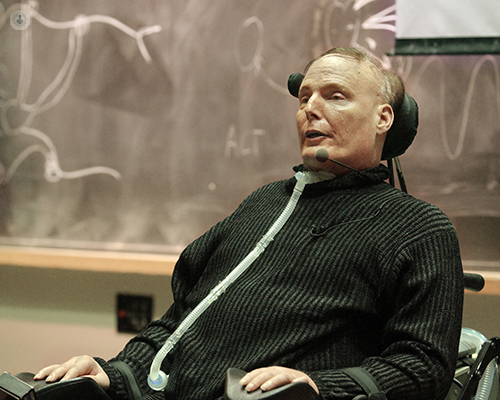


What is quadriplegia?
Quadriplegia, also known as tetraplegia, is a spinal cord injury that causes paralysis after an accident. Other causes include tumours or spinal cord diseases. The injury may cause partial or total limb paralysis (arms and legs).

There are five different types of spinal cord injuries:
- Complete spinal cord injury A: this is the most severe type. The patient has no sensation or motor function below the injury.
- Incomplete spinal cord injury B: patient has some sensation. Motor function is limited below the injury.
- Incomplete spinal cord injury C: patient has some sensation and muscle control, but the muscles are weak and non-functional.
- Incomplete spinal cord injury D: muscles are 75% functional.
- Incomplete spinal cord injury E: minor injury. The patient has almost normal sensation and strength.
Prognosis:
All spinal cord injuries are complex and a prognosis cannot be immediately given. Outlook will vary according to severity, which may have varying levels of disability, sensitivity and mobility. In many cases, the recovery is faster in the first six months, and small improvements may happen a year or two later.
What are the symptoms?
The first thing that needs to be assessed is the injury location. Injuries higher up in the spinal cord tend to cause more paralysis issues.
The most obvious symptom is limb deterioration, which can also affect torso function. This can cause the loss of control of several autonomic functions, including:
- Bladder and bowel
- Sexual function
- Digestion
- Breathing
- Loss of movement
- Loss or change in sensitivity
The general sense of feeling may be impaired in the affected areas, with symptoms including numbness, loss of sensitivity, or burning neuropathic pain.
Medical tests:
The doctor will carry out a physical examination and evaluate the patient’s symptoms. They will look over the patient’s medical history and carry out certain tests to check sensory function and movement.
Other tests may include:
- X-rays
- CT scan
- MRI scan
What causes it?
Quadriplegia is caused by damage to the spinal cord, cervical spine, or brain. Traffic accidents are the most common cause for spinal injuries, although injuries can also be caused by a tumour or spinal diseases. Conditions that could cause quadriplegia include; transverse myelitis, multiple sclerosis and Guillain-Barré syndrome.
The injuries may occur in children, before, during, or after birth. The most common cause is lack of oxygen in the brain due to poor oxygen supply. The lack of oxygen may be due to an infectious disease or complications during childbirth.
How can it be prevented?
It is important to take the appropriate safety measures when at work or exercising. Care should be taken not to dive in shallow water. Wearing a seat belt can reduce the risk of a serious injury in a traffic accident.
What is the treatment?
There is presently no specific treatment, this will depend on the extent of the injury and the patient’s condition. The loss of function and sensitivity in different parts of the body are addressed.
For spinal cord injuries, the main aim is to prevent further injury and to get the patient back to leading an active life as soon as possible.
Some treatments may include:
- Respiratory care
- Skin management and skin care
- Exercises to improve movement and strength
- Occupational therapy
- Bowel and bladder control programmes
What specialist should I see?
Quadriplegia is treated by a multidisciplinary team, which will vary according to injury severity. The team will normally include a neurologist, occupational therapist and a physiotherapist.